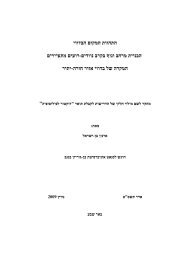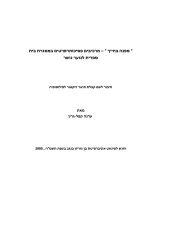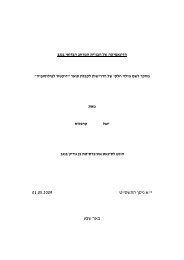Ben-Gurion University of the Negev Jacob Blaustein Institutes for ...
Ben-Gurion University of the Negev Jacob Blaustein Institutes for ...
Ben-Gurion University of the Negev Jacob Blaustein Institutes for ...
You also want an ePaper? Increase the reach of your titles
YUMPU automatically turns print PDFs into web optimized ePapers that Google loves.
14<br />
2.4.2 Miocenic calcareous aquifer in <strong>the</strong> area <strong>of</strong> Ragusa<br />
It is divided in: a) limestones in <strong>the</strong> area <strong>of</strong> Syracuse, approximately 630,8 km 2 wide; b)<br />
limestones in <strong>the</strong> area <strong>of</strong> Ragusa, approximately 467,7 km 2 wide. They show an<br />
elevated permeability and <strong>the</strong>y are situated in zones with precipitations between 800<br />
and 1100 mm per year. They contain an almost continuous stratum (in <strong>the</strong> porous layers<br />
and/or in <strong>the</strong> fractured ones) drained by a karst net developed all along <strong>the</strong> fault lines.<br />
The aquifer’s thickness can vary between 100 and 300 m.<br />
2.4.3 Volcanic aquifer in <strong>the</strong> area <strong>of</strong> Lentini<br />
It develops along <strong>the</strong> basin <strong>of</strong> Lentini and it also involves contiguous basins on a<br />
surface <strong>of</strong> 440 km 2 ; it shows moderate permeability. The area <strong>of</strong> recharge is compressed<br />
among <strong>the</strong> quotas 200 - 600 m and <strong>the</strong> precipitations are 550 - 800mm per year. The<br />
average thickness <strong>of</strong> <strong>the</strong> aquifer is approximately <strong>of</strong> 200 m; towards north <strong>the</strong> thickness<br />
<strong>of</strong> <strong>the</strong> vulcanites can sometimes go over 500 m. Permeability is limited to some parts <strong>of</strong><br />
<strong>the</strong> vulcanites (lapilli, breccias, fissured lavas, intercalated calcareous layers). The<br />
aquifer is partially drained by <strong>the</strong> hydrografical net; <strong>the</strong> aquifer’s exploitation is now<br />
per<strong>for</strong>med through numerous wells dislocated in <strong>the</strong> zone <strong>of</strong> Franc<strong>of</strong>onte, Palagonia,<br />
Lentini. As a result, this aquifer appears in phase <strong>of</strong> overexploitation.<br />
2.4.4 Plio-quaternary sandy-calcarenitic aquifer<br />
It essentially develops in <strong>the</strong> following areas: - area <strong>of</strong> Victoria-Caltagirone: outcrop <strong>of</strong><br />
about 110 km 2 ; - area <strong>of</strong> Piazza Armerina-Mazzarino: outcrop <strong>of</strong> about 840 km 2 ; -<br />
coastal plain from Trapani to Sciacca: outcrop <strong>of</strong> about 800 km 2 ; - Agro <strong>of</strong> Palermo,<br />
from Castellamare del Golfo to Termini Imerese: outcrop <strong>of</strong> about 430 km 2 .<br />
The most important basin, <strong>for</strong> extension and resources, is that <strong>of</strong> Victoria. It must be<br />
quoted, <strong>for</strong> memory, even <strong>the</strong> small outcrop <strong>of</strong> Licata-Gela, Agira, and Regalbuto,<br />
Augusta, and Syracuse and Avola.<br />
From <strong>the</strong> point <strong>of</strong> view <strong>of</strong> <strong>the</strong> morphology, <strong>the</strong> zones <strong>of</strong> <strong>the</strong> calcarenitis constitute some<br />
plains and some plateaus relatively <strong>of</strong> low quota (inferior to 160 m) divided into plates<br />
by <strong>the</strong> hydrographical net. Formation is moderately permeable. Its thickness varies from<br />
50-100 m in <strong>the</strong> basin <strong>of</strong> Victoria from 10 to 50 in <strong>the</strong> area <strong>of</strong> Palermo. It does not<br />
overcome 100 m in <strong>the</strong> coast plain from Trapani and Sciacca, instead it can reach 200-<br />
250 m in Piazza Armerina and Leon<strong>for</strong>te. Rainfalls in <strong>the</strong>se zones are on average low<br />
(from 500 mm to 700 mm per year) but some calcarenitic plates receive also a side<br />
supply by <strong>the</strong> limestones’ aquifers (areas <strong>of</strong> Syracuse, Victoria, Trapani, Palermo,<br />
Termini Imerese).
















